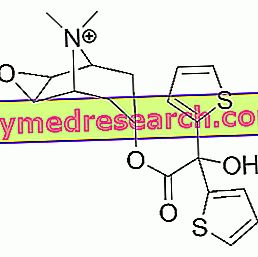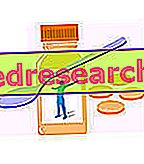Cabergoline is a synthetic derivative of ergotine, a natural alkaloid produced by the fungus Claviceps purpurea, also known as Ergot. Claviceps purpurea is an ascomycete that infests grasses, especially rye.

Cabergoline - Chemical Structure
When the rye is infested with this parasite it is called horned rye due to the sclerotia in the shape of small horns that this organism forms on the plant.
Indications
For what it uses
Cabergoline is indicated in the treatment of:
- Prolactin-secreting pituitary adenomas (a hormone used to stimulate the mammary glands and to produce milk);
- Hyperprolactinemia, that is, elevated blood concentrations of prolactin;
- Parkinson's disease;
- Galactorrhea, ie the abnormal secretion of milk in women who are not breastfeeding;
- In adjunctive acromegaly therapy.
Warnings
Cabergoline should be administered with caution in patients with pre-existing cardiovascular disease, hypotension, Raynaud's syndrome, peptic ulcer and gastrointestinal bleeding.
Attention should also be paid to the administration of cabergoline in patients with pre-existing renal and / or hepatic diseases.
Since cabergoline can cause sudden sleep attacks, it is strongly advised against driving or using machines by patients taking the drug.
Interactions
Concomitant use of macrolides (antibiotics, such as erythromycin ) and cabergoline may increase the plasma concentration of cabergoline itself, causing potentially dangerous effects.
Since cabergoline is a dopamine receptor agonist, it should not be given in combination with dopamin antagonist drugs or antipsychotic drugs .
It is recommended to avoid the use of cabergoline in association with ergot alkaloids for long periods of time, in order to avoid a possible enhancing effect.
Interactions may occur in concomitant use of antihypertensive and cabergoline drugs .
Side effects
Cabergoline can induce various types of side effects. Each patient responds differently to the therapy, therefore it is not said that the side effects all appear with equal intensity in each individual. Cabergoline-induced side effects are generally dose-dependent.
The following are the main adverse effects that may occur following treatment with the drug.
Psychiatric disorders
Cabergoline therapy can cause sleep disturbances, delusions, psychotic disorders, aggression, confusion and hallucinations .
Nervous system disorders
When taking cabergoline, the appearance of disorders such as dizziness, headache, dizziness, hyperkinesia or dyskinesia characterized by uncontrollable muscle movements, loss of coordination and / or balance is very common.
Furthermore, cabergoline can cause drowsiness and sudden sleep attacks in the absence of warning signs, making it very dangerous to drive vehicles and / or use machinery.
Cardiac disorders
Cabergoline can cause serious heart diseases, including cardiac valvulopathies (ie heart valve disorders), pericarditis (ie inflammation of the pericardium, the membrane that covers the heart) and pericardial effusions (accumulation of fluid in the pericardial space, ie the space included) between the pericardium and the heart). Moreover, cabergoline can promote the onset of angina pectoris .
Vascular pathologies
Cabergoline therapy can cause orthostatic hypotension, ie a sudden drop in blood pressure following the transition from a lying or sitting position to an upright position.
Raynaud's syndrome
Cabergoline treatment can cause Raynaud's phenomenon. It is a phenomenon characterized by an excessive spasm of peripheral blood vessels which causes a reduction in blood flow in the affected areas. The phenomenon occurs mostly in the fingers and toes, but can also involve other parts of the body. The skin of the affected areas usually takes on a yellow color that can become cyanotic and, finally - once the blood has been restored - it turns red.
Pleuropulmonary respiratory disorders
Cabergoline can cause pleural effusions and pleuropulmonary fibrosis . Furthermore, cabergoline can cause dyspnea and respiratory failure .
Gastrointestinal disorders
Cabergoline therapy can cause disorders such as gastritis, nausea, vomiting, dyspepsia (difficulty digesting) and constipation .
Impulse control disorders
Cabergoline treatment can cause serious impulse control disorders. These disorders include compulsive shopping or excessive shopping, pathological gambling, increased libido, hypersexuality, bulimia and the uncontrolled urge to eat.
Alteration of diagnostic tests
Cabergoline can cause a reduction in blood levels of hemoglobin and / or red blood cells. Furthermore, it can cause an increase in blood levels of creatine phosphokinase.
Other side effects
Other side effects that can occur after taking cabergoline are:
- Hypersensitivity reactions in sensitive subjects;
- Skin rash;
- Alopecia;
- Kidney failure;
- Urethral vascular obstruction;
- Abdominal vascular obstruction;
- Abdominal pains;
- Epistaxis;
- Leg cramps;
- Asthenia;
- Peripheral and non-peripheral edema;
- Fatigue;
- Hepatic impairment.
Overdose
The symptoms of any overdose may result from excessive stimulation of dopamine receptors. These symptoms are hypotension, nausea, vomiting, gastric upset, orthostatic hypotension, confusion or psychosis and / or hallucinations. If necessary, the non-absorbed drug must be eliminated from the body. For the treatment of symptoms, the use of dopaminergic antagonists could be useful.
Action mechanism
Cabergoline is an agonist of dopamine receptors and - as such - is able to mimic its biological effects. In particular, cabergoline acts on D2 receptors (type 2 dopaminergic receptors) located on cells responsible for prolactin release that are found in the anterior pituitary. By inhibiting the release of prolactin, cabergoline is able to interrupt the performance of the biological functions connected to it.
Cabergoline also interacts with dopaminergic neurons in the nigrostriatal area of the brain.
In patients with Parkinson's disease, there is a degeneration of nigrostriatal dopaminergic neurons and a decifit of the enzymes responsible for the synthesis of dopamine. This is why - for the treatment of this pathology - drugs are used that can act directly on dopaminergic receptors, such as cabergoline.
Mode of Use - Posology
Cabergoline is available for oral administration as tablets.
The dosage must be established by the doctor on the basis of the type of pathology to be treated. Furthermore, the response to the dosage of the drug administered - both as regards the effectiveness of the treatment and the side effects - seems to depend on the sensitivity of each patient.
Normally, the optimal dosage of cabergoline is achieved by gradually increasing the initial dose of the drug.
The usual doses range from 0.5 mg to 3 mg of the drug.
In any case, 3 mg of cabergoline per day should not be exceeded.
Pregnancy and breastfeeding
Cases of abortion or congenital malformations have been reported following the intake of cabergoline by the pregnant woman.
Before the beginning of treatment with cabergoline, the presence of a pregnancy must be excluded. Furthermore, it is necessary to take precautions - by both sexes - to avoid the onset of pregnancies both during the treatment and at the end of it, for a period of at least one month.
Therefore, treatment with cabergoline during pregnancy should be avoided, except in the case where the doctor does not consider it essential.
Cabergoline should not be used by breastfeeding mothers.
Contraindications
The use of cabergoline is contraindicated in the following cases:
- Known hypersensitivity to cabergoline or ergot alkaloids;
- In case of uncontrolled hypertension;
- History of pulmonary, pericardial and / or retroperitoneal fibrotic disorders;
- In case of pre-existing cardiac valve disorders;
- Pregnant.



